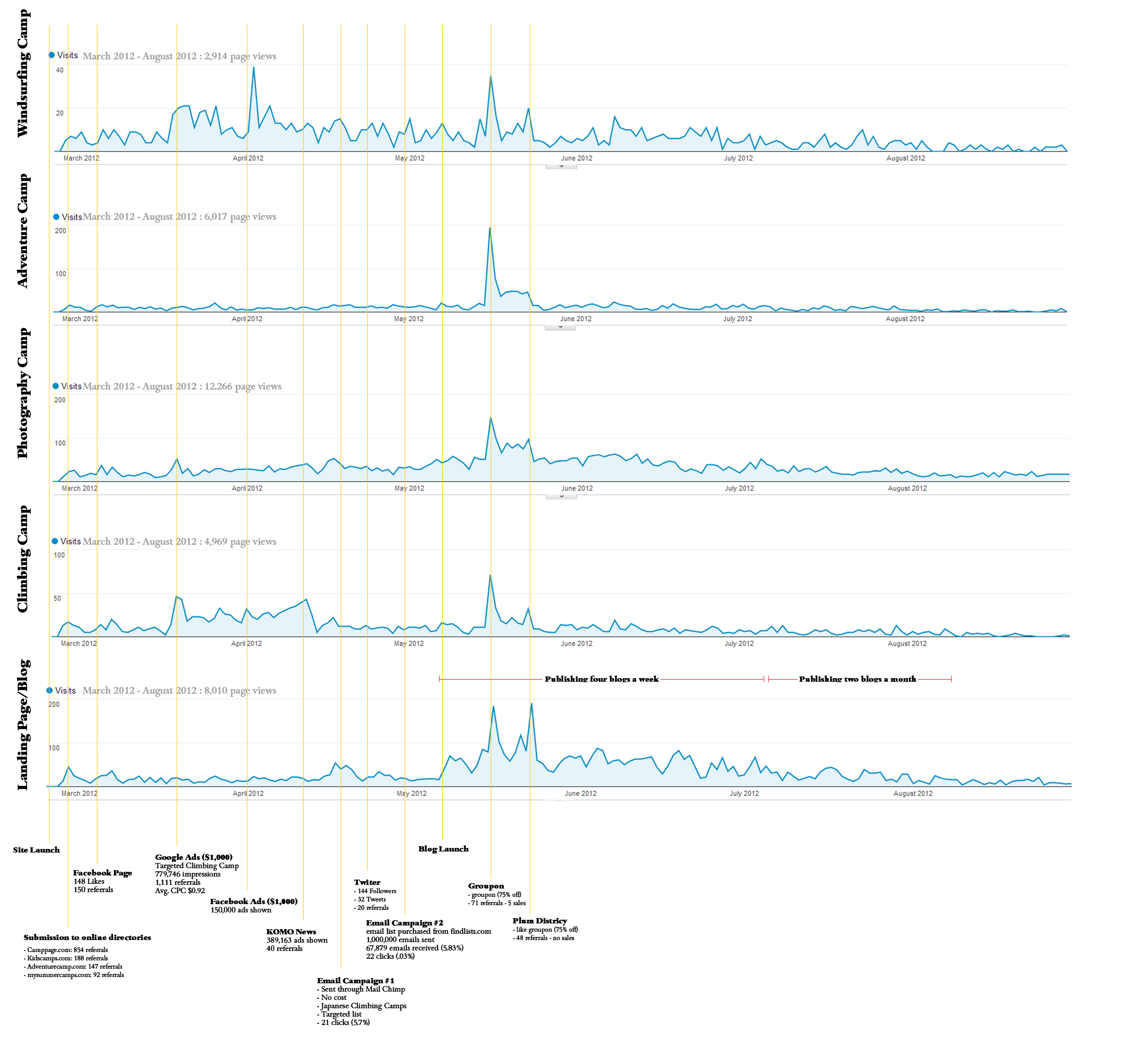Best Internet Marketing Techniques – A Case Study
Does online advertising work? What options are out there and what is the best return for your investment?
More and more the internet is becoming a primary marketing tool for many businesses, and those who have not yet taken the plunge are starting to get left behind. Most businesses accept the fact that without an online presence it’s hard to stay afloat, but with all the choices out there it’s easy to end up treading water, and instead of gaining more customers you can end up drowning in Tweets and Facebook posts that never seem to produce results.
To help those just getting their toes wet in the online ocean, we’ve put together a case study that shows you exactly what works and what doesn’t work when promoting your business online. The study below follows a start-up summer camp through their first year of business. The camp has four different camp specialties, each with it’s own website: Windsurfing, Photography, Climbing and Outdoor Adventure. The camp has a fifth website to act as a landing page. Over the course of 6 months they tried different marketing techniques, spending similar amounts of capital on each option.
A note about online scams: Once the camp owners began actively looking to promote their business online they were swamped with calls and emails from ‘marketing firms.’ About 90% of the people who contacted them were scammers. When promoting your business online always use a reputable company. Don’t listen to promises of ‘first page rankings’ or ‘guaranteed results.’ No one can guarantee you results on the internet, because they don’t control it. Shady marketing techniques can get you big jumps in web traffic, for short periods of time, but these aren’t real customers and whatever short term gains you may perceive will soon be lost.
The graph below shows visitors to each of the camp’s five websites with yellow lines showing the beginning of each marketing campaign. Most online ads would target the landing page, but some, like Google Ads targeted specific camps and therefore results are only seen for those camps.
What Worked … what didn’t
The camp tried many different types of advertising. The below comments are based on their experience and studying the analytics for the five websites.
Blog (Great investment)
– The absolute best thing you can do to drive traffic to your site and create customers is to have a blog, and post regularly. The more you post, the more people will find you online, and not just through ads, but because they are actively searching for what you are talking about. The most successful blog post was title “How to Choose a Camp for Your Child.” And more than one new registration came from people who read that post and were then turned on to the rest of the site. As long as you keep writing, people will keep reading. A common pitfall with blogs is to stop posting. You need to post at least once per week for a blog to benefit your site. In the graph above you’ll notice a gradual decline towards the end, this comes from the reduction in blog postings, in the highest levels four blogs were being posted per week, which clowed to one blog per month, and traffic returned to initial levels when blogging stopped altogether.
Submission to online directories (Great – especially for new websites)
– Every industry has online (and offline) directories that list companies and give consumers an easier way to find what their looking for. One of the best things you can do for a new site is get yourself listed in as many of these directories as possible. You want people to find your site, and no one is going to do that without links. Apply to the free ones first, and if you have any spare cash you can sign up for some of the paid directories. The camps signed up for four paid directories. The more expensive directory did not lead to more leads, so don’t sign up for the most expensive thinking it’s the best.
Here are some free directories to get you started: Manta | Yahoo! | YELP | Google Places
Google Ads (Most effective online advertising)
– Out of all the online advertisers only Google Ads produced any noticeable results. And they only charge when someone actually visited the site. Many other options (like Facebook Ads) charged per ad displayed, whether or not it drove traffic to the site. The Google Ads budget was focused on the Climbing Camp and while the ads were running, there was a noticeable increase in traffic. Not only directly from the ads, but search engine rankings also seemed to increase. The Google Ads ran for 1 month, and the day after they stopped we saw a marked drop in traffic to the Climbing Camp. On average Google ads cost $1 per visitor to the site.
Facebook / Twitter (Good for a long term plan)
– By themselves Facebook and Twitter will not draw customers. They work best as part of a long term strategy for interacting with past customers and staying in touch. When the Facebook / Twitter sites were first put up they generated no leads, and half the time we were tweeting to an empty room. But now as the camp rolls into it’s second year of operation, past campers and parents are using those forums to reconnect, share photos and get news. Both Facebook and Twitter should be connected to your blog, so that you only have to say things once.
Targeted Email (OK for contacting established customers)
– Email marketing is tricky, especially when trying to win over new customers. Generally you shouldn’t email people if they don’t specifically request it. The camp tried two different types email campaigns. The more succssful of the two was a targeted campaign to climbing schools located in Japan. One of the camp counselors had lived in Japan, and he used his connections to put together a carefully selected list of schools to email. A service called Mailchimp was used to send out the emails. Out of 427 emails 110 were opened and 21 people visited the website.
KOMO News (link farms) (Waste of time and money)
– KOMO News could be called a link farm. They create hundreds of websites targeting different areas of the country and topics. For example “Seattle, Washington Health and Fitness.” They then fill the pages with keywords and optimize the page for search engines, so that if people search for “Seattle Heath & Fitness” their site will come up at the top of the list. Then they sell advertising on that site. This was the second worst return on our inventment. Over 6 months of advertising only 40 people visited the website via KOMO News. Don’t advertise with these types of websites. You’d be better off spending the money to improve SEO for your own site.
Facebook Ads (Expensive with not much traffic increase)
– Out of 150,000 Facebook ad impressions purchased, only 85 people clicked through to the website. Compared to Google ads, Facebook advertising cost 1000% as much for the same results, not a good ROI. I should mention that the camp did not do the ads themselves, they hired a company called Fan Base Solutions. This is a company that only does Facebook advertising, and still this is the best they could do.
Groupon (75% of profits lost)
– In the graph there are two large spikes towards the middle. This was right before registration was ending, and in an attempt to fill the final spots the camp owners decided to put out a Groupon. The people at Groupon were tough negotiators, and after a week of phone calls the best deal we could work out was 50% customer discount – 25% to Groupon – 25% to the camp. Groupon was able to fill five of the remaining camper spots, but only at a net loss to the camp. Unless you plan on artificially inflating your prices, Groupon is a quick way to self-cannibalize your company, devalue your product, and will probably not produce return customers willing to pay full price the next time.
Plum District & Other Deal Sites (75% of profits lost)
– This was the second big spike. They produced some web traffic, but no sales. I think this would be the same for any similar deal site.
Linked In Ads (Waste of time)
– Linked In is not on the chart because after 2 months of running ads not a single person clicked through to the site. They charged per click, so the total cost was $0, but it ranks as a major waste of time.
Spam Email (1,000,000 emails = 22 visitors)
– Towards the end of registration a ‘marketer’ began contacting the camp director and tried to sell him on an email list. This was supposed to be a targeted email list of one million names, all in a specific geographic zone, above a certain income and with children in high school. The idea was that even if only 1% of the emails reached their target, that would still be 10,000 leads, and a good chance to get some new campers. Despite recommendations against it, the list was purchased. The list itself was expensive and a private company had to be hired to send out the emails (normal servers don’t send out 1,000,000 emails). Out of 1,000,000 emails only 5.83% turned out to be real addresses and of those 21 people clicked through to the website. The campaign resulted in no new signups.
Happy internet marketing, and please give us a call if you need some help navigating the wild seas of internet marketing.
If you’re interested in sharing this case study a pre-made presentation can be found here: http://prezi.com/mfubd8tfjzw7/does-online-marketing-work/
Drop Us a Line
It’s time to find some inspiring ideas for you!
Give us a call at (800) 288-7423 or fill out the form below
"*" indicates required fields




